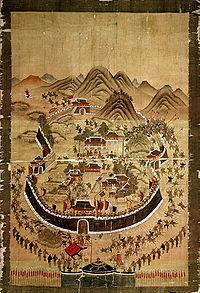18,000 men 2,500–3,000 men Date 15 April 1592 | 100 killed400 wounded (Japanese source) 3,000 killed500 POW Result Decisive Japanese victory | |
 | ||
Similar Japanese invasions of Korea, Siege of Busanjin, Battle of Chungju, Siege of Ulsan, Battle of Okpo | ||
The Siege of Dongrae was one of the first battles of the Imjin War resulting from Japanese invasions of Korea (1592–1597).
Contents
Background
After the fall of Busan, the Japanese army had to secure their bridgehead, because few kilometres to the north of Busan lay the fortress of Dongrae,a certain type of castle that was situated within a very strong position atop a hill, that dominates the main road north towards Hanseong.
The march and the Siege of Dongrae
After resting overnight at Busan, the First Division left at 6:00 AM the following morning, marched around the bay without delay, and began the attack on Dongrae two hours later. Its prefect, Song Sang-hyeon, hurriedly gathered all the town-people and what soldiers he could find such as Jo Yeong Gyu, the magistrate of Yangsan. As soon as the Japanese completed the investment of the fortress surrounding it in five lines, with other troops crowding on the nearby fields and prepared to storm the fortress. The prefect took up his position in the upper story of the great gate of the fortress where, in accordance with the Korean custom, he beat upon a great drum and urged on his soldiers in the fight. Like he had done previously at Pusan, Konishi Yukinaga presented the Japanese demands erected a certain message saying, "Fight if you want to, or let us pass", for a clear road through to China. It was again rejected by the prefect with the words, "it is easy for me to die, but difficult to let you pass”.Konishi Yukinaga then followed in personally leading the attack against Dongrae during the 15th day of fourth month, in which he ordered for the commander to be captured alive.
The Battle
After Busan, for a second time the ramparts of a Korean castle were swept with bullets. Even though the men that Song Sang-hyeon wielded were rather ill-equipped and poorly trained, the defenders fought for eight hours before the enemy effected an entrance over their dead bodies. An assault was made and at least 3000 of the defenders were slaughtered, but only after a fight lasting twelve hours.
The Fall
When Yi Gak, the cautious, and Gen. Bak Hong who was with him, heard the fall of Dongrae, they took their heels and consequently their force did likewise. After the fall of Dongrae many people were killed, which implies a massacre similar to that which happened at Pusan.
Aftermath
With the fall of Dongrae the Japanese bridgehead was secured and the road to the north was open. Busan and Dongrae fortress were quickly garrisoned, and the harbour of Busan began to provide a safe and almost unchallenged landing stage to disembark more than 100000 Japanese soldiers with their equipment, horses and supplies over the next month.
Legend
The Japanese general in command was so impressed with the bravery of this prefect that he had his body decently buried and erected over his grave a wooden monument on which he wrote “A Loyal Subject”, an epitaph than which none could be more grateful to a true Korean gentleman.
The cool defiance of Song Sang-hyeon has become a legend in Korea, and in the Chungnyolsa shrine at the foot of the castle hill in Dongrae, where he is honoured beside Chong Pal and Yun Heung-sin, there is a dramatic painting of him sitting impassively in his chair as the fierce Japanese approach.
